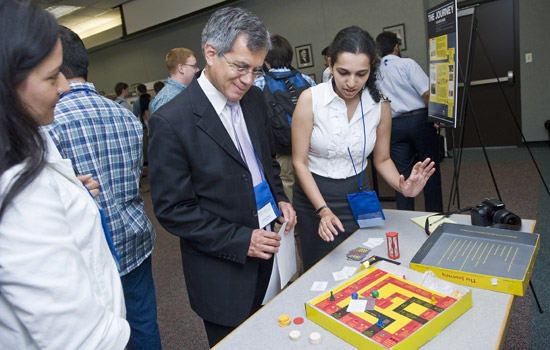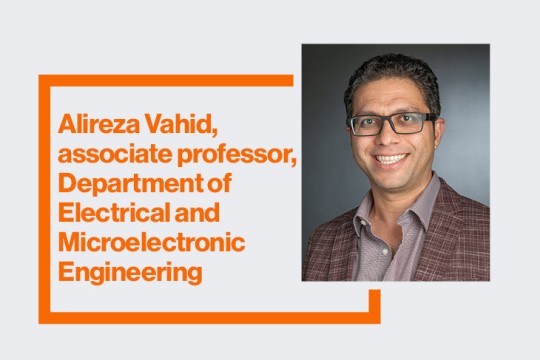Graduate students imagine, innovate and inspire
Students presented research to peers and Rochester community at annual symposium
A. Sue Weisler
Nicole Varble was among the graduate students who gave a poster presentation at the Graduate Research Symposium. Varble’s research focuses on ways to improve the fistula for patients undergoing hemodialysis.
The incoming dean of RIT’s Graduate Studies has devised a motto for the university’s graduate students: I3—Imagine, Innovate and Inspire.
Hector Flores shared his idea at the third annual Graduate Research Symposium held July 22 at RIT. The symposium gives master’s and Ph.D. students the opportunity to share their research with members of the RIT community and the general public. Flores was among the nearly 200 attendees.
He told graduate students: “I can say without reservation that none of the Big 10 schools have anything on you. You all should be proud of your work.”
Graduate students presented their research throughout the day to attendees.
Maria Shcherbakova, an MBA candidate in the E. Philip Saunders College of Business, spoke about her research on applying diversity management concepts to improve the minority education pipeline.
Shcherbakova, of Kazan, Russia, along with her advisor, Joy Oguntebi, an assistant professor in the E. Philip Saunders College of Business, and Lynn Wooten, a clinical associate professor at the University of Michigan, wrote a paper on the topic that has been conditionally accepted in The Decision Sciences Journal of Innovative Education.
“Getting diverse opinions about my work at events like this is good for me,” says Shcherbakova.
She was honored as having one of the top presentations at the symposium. Shcherbakova is returning to Russia soon to begin looking for a job. Procter & Gamble and several consulting firms are interested in talking with her.
“For me, as an international student, RIT has been amazing,” she adds. “A lot of big companies are involved in the MBA program, so I learned a lot about real-life solutions.”
Devising a real-life solution for those patients undergoing hemodialysis is the research focus of Nicole Varble. Varble, of Henrietta, earned her B.S./M.S. in mechanical engineering. Her graduate research looks at ways to improve the fistula, or the bridge between the arteries and veins used as an access point during hemodialysis, to increase blood flow to a patient’s hand without removing the fistula. She was among the graduate students who gave a poster presentation at the symposium. Varble won for best poster presentation.
She is now pursuing a degree at the University of Rochester in biomedical engineering with a concentration in cardiovascular device design.
Yerbol Yembergenov, an information technology master’s student from Kazakhstan, is working on a mobile application that provides a university tour of the RIT campus. It would map out campus buildings, parking lots, vending machines and even microwaves.
“From this symposium, I received more suggestions from people about improving the project,” says Yembergenov. “This mobile app is going to be for the RIT community so I welcome the constructive criticism and hearing people’s expectations.”
Three Ph.D. students from North Carolina A&T University also attended the symposium and presented their research. RIT is establishing a new relationship with the university.
RIT President Bill Destler told attendees: “Graduate students are part of the engine that moves the body of knowledge forward. Your ideas and concepts drive our economy. The future depends on the work that you do.”
Ryne Raffaelle, RIT vice president for research and associate provost, gave the keynote address. The theme of his address was serendipity, or an aptitude for making discoveries happen by accident.
For Raffaelle, it was sitting in a physics lecture in high school and hearing about solar cells and a scholarship opportunity at Southern Illinois University. The topic of solar cells wasn’t something Raffaelle had ever had an interest in until he heard the lecture. He applied for and won the scholarship and eventually went on to become the director of the National Center for Photovoltaics at the National Renewable Energy Lab, one of the premier research and development labs for solar cell technology.
“The future is invented, not predicted,” says Raffaelle. “It’s when that something happens that you didn’t expect.”
Symposium awards were given out in various categories: best morning session presentations, top afternoon presentations, overall best presentation and top poster presentation.
Other award winners included Brian Gamm, color science Ph.D. candidate for his presentation, “An Analysis of the Factors Influencing Paper Selection for Books of Reproduced Fine Art Printed on Digital Presses.” Gamm won for best overall presentation. Shcherbakova and Yugiong Wang, a student in the computing and information sciences doctoral program, earned honors for their morning presentations. Wang’s presentation was titled “Information from the Face.” Afternoon session winners were Roberta DiLeo, microsystems engineering Ph.D. candidate, “High Energy and High Power Density Semiconductor-Carbon Nanotube Anodes for Lithium Ion Batteries” and Chris Schauerman, sustainability Ph.D. candidate, for his presentation “Recycling and Reuse of Single-Wall Carbon Nanotubes from Lithium Ion Batteries.”
 Hector Flores, dean of RIT’s graduate studies, gets a closer look at a board game called The Journey. It was designed by Shweta Shidhore, right, an MFA student in RIT’s graphic design program. A. Sue Weisler
Hector Flores, dean of RIT’s graduate studies, gets a closer look at a board game called The Journey. It was designed by Shweta Shidhore, right, an MFA student in RIT’s graphic design program. A. Sue Weisler














